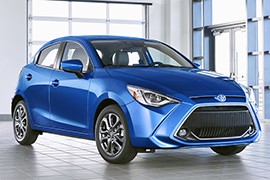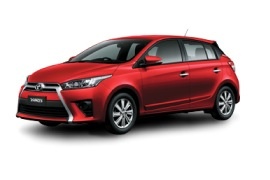TOYOTA Yaris Hatchback Models/Series Timeline, Specifications & Photos
First production year: 2013
Engines: Gasoline
Body style: Hatchback
Toyota tried to get a share of the U.S. small-segment market and introduced the Yaris hatchback in 2018, but the customers were up for a surprise.
It was not unusual for the Japanese carmaker to sell small-segment vehicles on various markets. Still, it was unusual for it to sell re-badged vehicles, such as the Yaris hatchback. Behind that Toyota badge on the grille, the car was a Mazda 2.
From the outside, only the headlights might give a clue that under that bodywork was a Mazda 2 vehicle. At the front, the huge grille from the lower side of the bumper reminded us of the "Jaws" movie, while the two sculptured lines from its sides might remind you of the Storm Troopers masks. Unlike its sedan sibling, the Yaris hatchback featured a sloped, curved rear end. Its tailgate tall opening was good in creating a low loading area, but it was not that wide.
Inside, it was a Mazda 2 from top to bottom, except for a few Toyota upgrades. The carmaker installed a 7" infotainment touch-screen on top of the center stack for the entire range. An additional rotary knob placed between the front seats could also control the unit. Toyota claimed a 15.9 cu-ft (450 liters) trunk size.
Under the hood, Toyota offered the Yaris with only one engine option, a 1.5-liter gasoline unit. It paired it with a six-speed automatic as standard.
Toyota developed a unique small-segment hatchback for specific countries and used the same Yaris nameplate, even though it wasn't the same vehicle.
Produced for South-East Asia and South America, the 2013 Yaris XP150 was the kind of vehicle that those customers needed. It was an econobox built responsibly by the big Japanese carmaker. While it lacked in some areas regarding pollution or safety, it gained on the price tag. Moreover, even though it shared its platform with the European and American siblings, it featured a 40 mm (1.6") longer wheelbase. Toyota built it as a five-door hatchback or a four-door sedan.
While it didn't have to comply with the strict European emission standards or with the Californian rules, the carmaker considered that it shouldn't cut the design department's budget. Thus, the Indian-built Yaris featured a pair of slim, angular headlights with a thinner upper line extended over the front fenders. Its profile revealed a raked windshield followed by a slightly curved top and ended with a tiny spoiler. On the C-pillar, a darkened area created the image of a floating design roof.
Inside, it wasn't the most spacious car from Toyota's stable, but it offered better legroom for the rear passengers than its European or American sibling. Its design team made a binocular-style instrument cluster with the speedometer in the middle flanked by a tachometer on the left and the fuel level on the right panel. The carmaker provided an automatic climate control unit and a five-speed automatic transmission depending on the trim level.
Under the hood, Toyota installed a 1.2-liter powerplant paired with a five-speed manual or an automatic (CVT) transmission.

